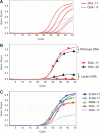Zip nucleic acids are potent hydrolysis probes for quantitative PCR
- PMID: 20071749
- PMCID: PMC2853127
- DOI: 10.1093/nar/gkp1218
Zip nucleic acids are potent hydrolysis probes for quantitative PCR
Abstract
Zip nucleic acids (ZNAs) are oligonucleotides conjugated with cationic spermine units that increase affinity for their target. ZNAs were recently shown to enable specific and sensitive reactions when used as primers for polymerase chain reaction (PCR) and reverse-transcription. Here, we report their use as quantitative PCR hydrolysis probes. Ultraviolet duplex melting data demonstrate that attachment of cationic residues to the 3' end of an oligonucleotide does not alter its ability to discriminate nucleotides nor the destabilization pattern relative to mismatch location in the oligonucleotide sequence. The stability increase provided by the cationic charges allows the use of short dual-labeled probes that significantly improve single-nucleotide polymorphism genotyping. Longer ZNA probes were shown to display reduced background fluorescence, therefore, generating greater sensitivity and signal level as compared to standard probes. ZNA probes thus provide broad flexibility in assay design and also represent an effective alternative to minor groove binder- and locked nucleic-acid-containing probes.
Figures




Similar articles
-
Zip nucleic acid: a new reliable method to increase the melting temperature of real-time PCR probes.J Diabetes Metab Disord. 2014 Feb 4;13(1):26. doi: 10.1186/2251-6581-13-26. J Diabetes Metab Disord. 2014. PMID: 24495816 Free PMC article.
-
Zip Nucleic Acids: new high affinity oligonucleotides as potent primers for PCR and reverse transcription.Nucleic Acids Res. 2009 Oct;37(19):e130. doi: 10.1093/nar/gkp661. Epub 2009 Aug 20. Nucleic Acids Res. 2009. PMID: 19696078 Free PMC article.
-
Oligonucleotide-oligospermine conjugates (zip nucleic acids): a convenient means of finely tuning hybridization temperatures.J Am Chem Soc. 2008 Oct 8;130(40):13500-5. doi: 10.1021/ja804727a. Epub 2008 Sep 10. J Am Chem Soc. 2008. PMID: 18781743
-
Single nucleotide polymorphism genotyping using locked nucleic acid (LNA).Expert Rev Mol Diagn. 2003 Jan;3(1):27-38. doi: 10.1586/14737159.3.1.27. Expert Rev Mol Diagn. 2003. PMID: 12528362 Review.
-
Homogeneous detection of nucleic acids using self-quenched polymerase chain reaction primers labeled with a single fluorophore (LUX primers).Methods Mol Biol. 2006;335:95-114. doi: 10.1385/1-59745-069-3:95. Methods Mol Biol. 2006. PMID: 16785623 Review.
Cited by
-
Recent Progress on Optical Biosensors Developed for Nucleic Acid Detection Related to Infectious Viral Diseases.Micromachines (Basel). 2023 Jan 23;14(2):295. doi: 10.3390/mi14020295. Micromachines (Basel). 2023. PMID: 36837995 Free PMC article. Review.
-
Zip nucleic acid: a new reliable method to increase the melting temperature of real-time PCR probes.J Diabetes Metab Disord. 2014 Feb 4;13(1):26. doi: 10.1186/2251-6581-13-26. J Diabetes Metab Disord. 2014. PMID: 24495816 Free PMC article.
-
High precision and high yield fabrication of dense nanoparticle arrays onto DNA origami at statistically independent binding sites.Nanoscale. 2014 Nov 21;6(22):13928-38. doi: 10.1039/c4nr03069a. Nanoscale. 2014. PMID: 25311051 Free PMC article.
-
Electrochemical Detection of Solution Phase Hybridization Related to Single Nucleotide Mutation by Carbon Nanofibers Enriched Electrodes.Materials (Basel). 2019 Oct 16;12(20):3377. doi: 10.3390/ma12203377. Materials (Basel). 2019. PMID: 31623126 Free PMC article.
-
Cationic Oligospermine-Oligonucleotide Conjugates Provide Carrier-free Splice Switching in Monolayer Cells and Spheroids.Mol Ther Nucleic Acids. 2018 Dec 7;13:483-492. doi: 10.1016/j.omtn.2018.09.027. Epub 2018 Oct 10. Mol Ther Nucleic Acids. 2018. PMID: 30388622 Free PMC article.
References
-
- Saiki RK, Scharf S, Faloona F, Mullis KB, Horn GT, Erlich HA, Arnheim N. Enzymatic amplification of beta-globin genomic sequences and restriction site analysis for diagnosis of sickle cell anemia. Science. 1985;230:1350–1354. - PubMed
-
- Higuchi R, Dollinger G, Walsh PS, Griffith R. Simultaneous amplification and detection of specific DNA sequences. Biotechnology. 1992;10:413–417. - PubMed
-
- Kubista M, Andrade JM, Bengtsson M, Forootan A, Jonak J, Lind K, Sindelka R, Sjoback R, Sjogreen B, Strombom L, et al. The real-time polymerase chain reaction. Mol. Aspects Med. 2006;27:95–125. - PubMed
-
- Livak KJ, Flood SJ, Marmaro J, Giusti W, Deetz K. Oligonucleotides with fluorescent dyes at opposite ends provide a quenched probe system useful for detecting PCR product and nucleic acid hybridization. PCR Methods Appl. 1995;4:357–362. - PubMed
-
- Tyagi S, Kramer FR. Molecular beacons: probes that fluoresce upon hybridization. Nat. Biotechnol. 1996;14:303–308. - PubMed
Publication types
MeSH terms
Substances
LinkOut - more resources
Full Text Sources
Other Literature Sources
Research Materials

